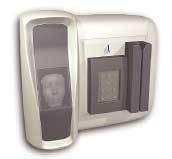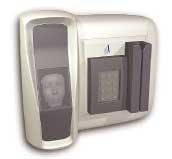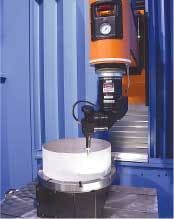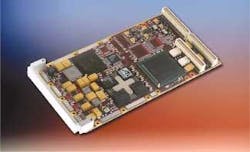Premier Electronics unveils real-time 3-D facial-recognition systems
Officials of Premier Electronics Ltd. in Waltham Cross, England, are introducing their A4 Door Access Control Face Reader (FR) system that combines standard digital photography with 3-D facial recognition generation. The result is a recognition and identification system with the ability to produce a standard digital photograph for identity cards, Premier officials say. Developed by A4 Vision in Cupertino, Calif., this system is now available from Premier Electronics. The product comes in two versions — an enrollment or identification/verification, and an identification/verification unit. The enrollment unit provides a color digital picture of the subject and a 3-D facial template, and can combine these two formats to provide a 3-D-face mask. The digital picture goes on identity cards with a special holographic print. The unit also supplies a 100-megabit-per-second Ethernet connection to interface with remote identification/verification units. The other unit is just for identification/verification and connects to the enrollment station via Ethernet. Subjects walk up to the unit and either present a card and look into the mirror if working in the verification mode or just look into the mirror if in the identification mode. For more information contact Darryl Coffey at Premier Electronics by phone at 011-44-1992634652, or online at www.premierelect.co.uk.
Actel offers fast FPGAs qualified to military specs
Officials of Actel Corp. in Mountain View, Calif., are qualifying their company's nonvolatile Axcelerator family of field-programmable gate arrays (FPGAs) to operate over the full military temperature range of –55 to 125 degrees Celsius. The Axcelerator devices implement 66-MHz PCI and 1-gigabyte-per-second Fibre Channel designs. The single-chip AX2000, AX1000, AX500, and AX250 devices come in military-temperature plastic (MTP), military-temperature hermetic (MTH), and hermetic packaging screened to MIL-STD 883B. These devices have densities of as many as 2 million system gates and as much as 288 kilobits of memory. The Axcelerator family is suitable for military and avionics applications requiring high bandwidth, such as radar, communications, and weapons systems. The Axcelerator family is built on the company's AX antifuse-based architecture, and delivers 500-MHz internal operation and as much as 100 percent resource utilization, company officials say. For more information contact Actel by phone at 888-992-2835, or online at www.actel.com.
Elma offers lighted knobs to improve visibility of indicator characters
Elma Electronic in Fremont, Calif., is offering a line of illuminated knobs in various sizes and styles to make viewing of indicator characters easy, even in darkness. This product lights the figure dial under a knob with SMD LEDs on a flexible PCB strip inside a figure dial made of proprietary lightguide material. The illumination of the lightguide figure dial makes viewing of the indicating characters easier in all ambient light conditions, from a dark room to sunlight. Standard lightguide figure dial marking is available off the shelf, and customer-specific marking is available. All marking is done on the underside of the dial to alleviate problems with character deterioration over time. The lightguide figure dial and flexible LED strip are for standard Elma knobs in 20- to 30-millimeter sizes in several styles, or for other manufacturer's knobs. Custom knobs are available with illuminated indicator lines, dots, or characters within the knob itself. An optional knob skirt with single viewing window is available that highlights only one illuminated character on the figure dial at one time for exact position selection. Standard LED colors are super-red, yellow, orange, green, blue, and white. Mixtures of colors are available as a special order, as are colored lightguide figure dials. For more information contact Elma by phone at 510-656-3400, or online at www.elma.com.
Laserdyne optical focus control enhances laser processing
Leaders of Laserdyne Systems in Champlin, Minn., are offering optical focus control (OFC) on all of the company's 790 BeamDirector systems for applications such as precision drilling of cooling holes in thermal-barrier-coated turbine-engine components. The optical-focus-control feature also helps improve focus control at the precise location of the drilled hole, company officials say. In one application, for example, OFC reduced the time for drilling a pattern of shallow-angle cooling holes by 24 percent by eliminating the time to measure the distance between the laser focal point/gas-assist nozzle and work piece. OFC has increased sensing frequency compared with capacitance-based sensors, which enables it to follow a surface under closed-loop control at twice the speed of AFC while avoiding the need to find the surface location. OFC senses part surfaces inaccessible to conventional AFC nozzles and it eliminates side-sensing problems that can occur with nozzle-based sensors. For more information contact Laserdyne by phone at 763-433-3700, or online at www.prima-na.com.
Newport expands line of high-speed photodetectors
Officials of Newport Corp. in Irvine, Calif., expanded their range of high-speed photodetectors that are based on indium gallium arsenide (InGaAs), gallium arsenide (GaAs), and silicon. These photodetectors provide spectral response from the visible through the near-infrared — or from 400- to 1,700-nanometer wavelengths. The new additions deliver a wide selection of picosecond products, fast commercial visible detector (7 picosecond), and a detector package with 1-MHz response that incorporates tunable gain and filters. These photodetectors are for research laboratory applications in laser-based research as well as applications in test and measurement and communications development, in which their integrated packaging provides simple, turnkey operation. Options include either free-space or fiber-coupled inputs and the choice of high- or low-impedance termination. Specific applications of these detectors include temporal profiling of nanosecond lasers and monitoring chirped amplification of ultrafast laser pulses. The new additions include additions to the 818-BB series of biased photodetectors that provide low-cost solutions for applications requiring a 10-GHz bandwidth; the 818-GF photodetector that incorporates variable gain and adjustable low- and high-frequency filters; and the PX-D7 fast visible detector with a response time of 7 picoseconds, representing a frequency response of 60 GHz. For more information contact Newport by phone at 949-863-3144, or online at www.newport.com.
Dy 4 graphics PMC board doubles video-system density
Officials of Dy 4 Systems in Kanata, Ontario, are introducing a new member of the company's Insights graphics-board family called the PMC-704. Based on the ATI Mobility Radeon 9000 graphics-processing engine, also known as the M9 chip, the board has two independent channels, each with video input, overlay, and display capability. The PMC-704 helps designers build systems with new visualization techniques including stereo helmet-mounted displays, 3-D terrain mapping, electronic panning and stabilization, and "transparent vehicle" virtual displays. The ability to drive four displays from one slot with two PMCs reduces system size, power, and cost, Dy 4 officials say. The board's M9 chip operates at 250 MHz, with a 64-megabyte, 128-bit-wide DDR SDRAM frame buffer. The card provides two independent outputs that support analog monochrome or RGB, LVDS, and DVI digital interfaces. The card provides two independent analog video input channels and a digital input supporting OpenLDI and FlatLink LVDS digital video standards. Each live video channel can display independently on any one, or both output displays. Dy 4 partnered with ALT Software to implement industry-standard X11 and OpenGL. The board supports several real-time operating systems including VxWorks from Wind River and Integrity from Green Hills Software. Support for Timesys Linux and LynxOS from LynuxWorks is planned for future releases. For more information contact Dy 4 Systems at 613-599-9191, or online at www.dy4.com.








